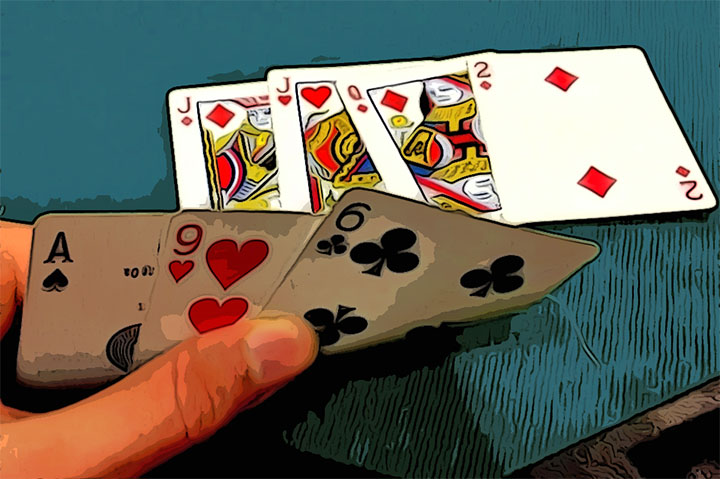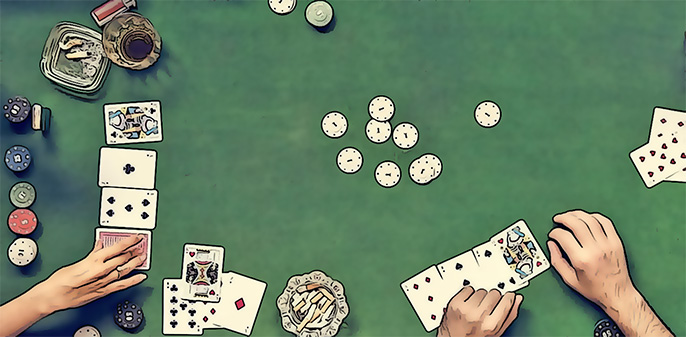One of the more complex games in the HORSE mix, Seven Card Stud Hi-Lo poker, also known as Seven Card Stud 8 or Better, is a split game that includes lowball poker elements.
As the name suggests, pots in this game are split between the high and the low hand, with two separate sets of poker hand rankings used to determine the winners of each half.
If you have played Seven Card Stud or Razz poker before, getting acquainted with Seven Card Stud Hi-Lo should not be too difficult.
However, if you are completely new to Stud games, then this guide to Seven Card Stud Hi-Lo rules is exactly what you need to learn the game from the ground up.
Before we proceed to explain the hi-lo element of the game and the hand rankings, let’s start with the simpler things, such as obligatory bets, dealing, and betting streets.
- Seven Card Stud Hi-Lo Basics: Antes, Bring-In, and Third Street
- Fourth Street in Seven Card Stud Hi-Lo Poker
- Fifth Street in Seven Card Stud Hi-Lo Poker
- Sixth Street in Seven Card Stud Hi-Lo Poker
- Seventh Street in Seven Card Stud Hi-Lo Poker
- Showdown in Seven Card Stud Hi-Lo Poker
- Low Hand in Seven Card Stud Hi-Lo
- Choosing a Starting Hand in Seven Card Stud Hi-Lo
- Importance of Folded Cards in Seven Card Stud Hi-Lo
- Straightforward Play is Rewarded in Stud 8 or Better
- Start Learning Stud 8 Online
Seven Card Stud Hi-Lo Basics: Antes, Bring-In, and Third Street

For players transitioning over from flop games like Texas Hold’em or Pot Limit Omaha, getting familiar with Stud games can take some doing, as Stud poker does not include any community cards.
Instead, players receive a total of seven hole cards, three of which are dealt face down and four of which are dealt for the entire table to see.
The objective of the game is to either make your opponents fold their cards and win the pot or make the best hand in accordance with poker hand rankings.
However, in Seven Card Stud Hi-Lo we use two different sets of hand rankings, with one used for the high portion of the hand and another used for the low.
While we will explain who wins which part of the pot a bit later, we must first explain how the game is played and what happens before the winners are announced.
Each hand of Seven Card Stud Hi-Lo poker stars with every player at the table posting an ante bet, which is set at a fraction of the big bet and is used to drive action.
Once all the antes are in, the dealer deals three cards to each player, with two dealt face down and the third, known as the door card, dealt face up.
At this point, the dealer determines which player has the lowest door card at the table, and this player must post the bring-in, which is a forced bet usually worth 50% of the small bet.
The player who posts the bring-in can also choose to complete one small bet, and the action starts with the player to their immediate left, continuing clockwise around the table.
This first round of betting in Seven Card Stud Hi-Lo is known as third street, and it is the first opportunity for players to act on their hands.
All players get a chance to raise the bet in increments of one small bet, with up to three raises possible over the initial bet.
Fourth Street in Seven Card Stud Hi-Lo Poker
Once every player has acted on their hand on third street, the dealer will deal another card face up to all players who have not yet folded their cards.
This time around, it is the player whose two exposed cards have the highest poker value who acts first. The player with the highest exposed card, or the highest exposed pair, gets to play first.
Unlike in a typical Seven Card Stud, the option to make bets in big bet increments if you have a pair on fourth street does not exist. Instead, all fourth street bets can only be made in small bet increments.
Once a player makes a fourth street bet, up to three raises are allowed on top of it, each of them worth exactly one small bet.
Fifth Street in Seven Card Stud Hi-Lo Poker
Once the fourth street is complete, another face up card is dealt to all remaining players, and the fifth street of betting can begin.
On fifth street, the player with the best poker hand once again gets to play first. Note that it’s possible for the player to go first and can change between streets as players’ hands improve.
This time around, the big bet comes into play, and players can only make bets in increments of one big bet at a time, with one bet and up to three raises possible.
Once again, the action goes around the table in a clockwise fashion until all bets have been settled and the next card can be dealt.
Sixth Street in Seven Card Stud Hi-Lo Poker
Following fifth street betting, the dealer puts out the sixth card for each remaining player, with everyone now sitting on four exposed cards and two hole cards.
Once more, the player with the strongest exposed hand gets to play first. The action goes clockwise around the table, and big bet increments are used.
The action between fifth and sixth street flows the same way, and it is very common to see players who stay in the hand after fifth also proceed following sixth street.
Seventh Street in Seven Card Stud Hi-Lo Poker
The final, seventh betting street in Seven Card Stud Hi-Lo comes after the dealer deals out the seventh card to each active player.
The final card is dealt face down, which means only the player who receives it gets to benefit from seeing it.
Since no new exposed cards are dealt, the action on seventh street will start with the same player who played first on the sixth, provided that the player did not fold.
Once again, bets are made in big bet increments, and the action goes clockwise around the table until all bets are settled.
Showdown in Seven Card Stud Hi-Lo Poker
Once seventh street betting is done, the dealer announces showdown, and the remaining players in hand are asked to turn over their hole cards.

At showdown, the player who bet first on seventh street is the first to show, while other players show in clockwise order around the table.
At this point, the dealer determines the winner or multiple winners of the hand. In Seven Card Stud Hi-Lo, players will split the pot if at least one of them qualifies for the low half of the pot. If neither player qualifies for the low, the player with the best high hand wins the whole pot.
While high hands are determined in accordance with the usual poker hand rankings, let’s take a look at how the best low hand is determined.
Low Hand in Seven Card Stud Hi-Lo
If you are not sure about overall poker hand rankings, you can check those out in our guide to Seven Card Stud poker.
When it comes to the low hand, however, it’s time to explain the rules of how it is determined right here.
The game uses Ace to Five or “California” rules when it comes to the low hand. By these rules, straights and flushes do not count, and only cards 8 or lower count for the low hand.
In order to even compete for the low end of the pot, you will need to have five unpaired cards that are 8 or lower.
Considering this rule, the best possible low hand in Seven Card Stud Hi-Lo poker is 5 4 3 2 A of any suit, also known as “wheel.”
It is important to note that your highest “low” card is the first to look at when comparing hands, which means any seven low is better than every eight low regardless of other cards, etc.
The next time you play Seven Card Stud Hi-Lo poker, make sure to remember that you can only win the low half of the pot if you have five low cards and that your pairs will not count towards the low, and you will be good to go.
Choosing a Starting Hand in Seven Card Stud Hi-Lo
The one thing that many poker players get wrong in Seven Card Stud Hi-Lo has to do with hand selection on third street.
At this point in the hand, you get to see three of your seven cards, and this is the time to pick which hands you want to play and which you want to fold.
Choosing the right hands to play in Seven Card Stud Hi-Lo is very important, and good hand selection is key to success.
The first thing to think about is whether your hand can actually win both parts of the pot, as playing for just the high half is usually a losing proposition.

Combinations of low cards with an Ace or a Deuce can be great starting hands, with the likes of As 2s 3s being perfect candidates to get a lot of bets in on the early betting streets.
On the other hand, hands like Ks Qs Js, which are amazing starting hands in Seven Card Stud, lose a lot of their value in Seven Card Stud Hi-Lo, as they automatically disqualify you from winning the low half.
Middling straight and flush cards can also be good to start with, as they give you a chance to win both ways, while low cards that are not suited can be good depending on their connectedness and action from other players.
Importance of Folded Cards in Seven Card Stud Hi-Lo
When playing Seven Card Stud Hi-Lo, and any other Stud poker game for that matter, it is incredibly important to remember all the door cards you saw on third street and other cards folded on later streets.
Knowing which cards have been folded will let you better understand your odds and know just how likely you are to hit any potential draw you are chasing.
Both high cards that seemingly don’t matter for your hand and low cards that might be important on later streets, so make sure to try and memorize every card that was thrown into the muck but shown before that.
Straightforward Play is Rewarded in Stud 8 or Better
One thing to remember about Seven Card Stud Hi-Lo is that this is the one game in which you don’t want to be the hero or bluff too much.
Overall, the general population does not bluff too much in Stud 8, and you can expect people to usually have what they are representing.
For that reason, your best way to win at this game is to play fairly tight on third street, play better hands than your opponents, and simply win more pots by showdown due to pure pot odds.
Most players actually play way too many hands in Seven Card Stud Hi-Lo, which is the best place where you can find value and win big consistently.
If you can find the right games to play, with plenty of loose players who play too many hands, Seven Card Stud Hi-Lo can be one of the most profitable and least variance-impacted poker games out there.
So, if you are looking to play with minimal variance and a high win rate, try to find a splashy Stud 8 game, and you will see yourself printing money in the long run.
Start Learning Stud 8 Online
The one great thing about Seven Card Stud Hi-Lo and other Seven Card Stud games, unlike Five Card Stud, is that you can start learning them online.
At least one online poker operator currently offers Seven Card Stud Hi-Lo games, and you can find daily tournaments and occasional cash games for very low stakes, giving you a great opportunity to learn the game with minimal risk.
We highly recommend playing these games until you master Seven Card Stud Hi-Lo rules and basic strategy, before you can start looking for great live games to play in and start crushing those splashy live players.
